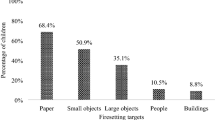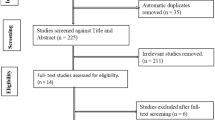Abstract
Children’s reactions to residential fires were explored using a qualitative methodology. Forty-four children (n = 44) between the ages of 6 and 18 (23 female and 21 male) participated. The youth were interviewed using two instruments that assessed levels of psychological distress and explored their perceptions regarding their experiences of the fire. The following five themes were identified through qualitative analysis of the interview transcriptions: vivid description, fear/trauma, physical injury, losses, and gains. Implications for future research and intervention are discussed.
Similar content being viewed by others
References
Deković M, Koning I, Stams G, Buist K (2008) Factors associated with traumatic symptoms and internalizing problems among adolescents who experienced a traumatic event. Anxiety Stress Coping Int J 21(4):377–386
Greenberg H, Keane A (2001) Risk factors for chronic posttraumatic stress symptoms and behavior problems in children and adolescents following a home fire. Child Adolesc Soc Work J 18(3):205–221
Jones RT, Ollendick TH (2002) Residential fires. In: LaGreca AM, Silverman WK, Vernberg EM, Roberts MC (eds) Helping children cope with disasters and terrorism. American Psychological Association, Washington, DC, pp 175–199
Jones RT, Ribbe DP, Cunningham PB, Weddle JD, Langley AK (2002) Psychological impact of fire disaster on children and their parents. Behav Modif 26(2):163–186
Langley A, Jones RT (2005) Post-traumatic symptomatology in adolescents following wildfire: the role of coping strategy and efficacy. Fire Technol 41(2):125–143. doi:10.1007/s10694-005-6387-7
Immel CS, Jones RT (2009) Posttraumatic stress disorder and symptom subclusters symptoms as a mediator of self-reported somatic health distress among trauma survivors (in preparation)
Jones RT, Ribbe DP (1991) Child, adolescent and adult victims of residential fire. Behav Modif 139:560–580
Greenberg HS (1994) Responses of children and adolescents to a fire in their homes. Child Adolesc Soc Work 11:475–492
Green BL, Grace MC, Crespo da Silva L, Gleser GC (1983) Use of the Psychiatric Evaluation Form to quantify children’s interview data. J Consult Clin Psychol 51:353–359
Grilles AE, Ollendick TH (2003) Multiple informant agreement and the Anxiety Disorders Interview Schedule for parents and children. J Am Acad Child Adolesc Psychiatry 42(1):30–40
Earls F, Smith E, Reich W, Jung KG (1988) Investigating psychopathological consequences of a disaster in children: a pilot study incorporating a structured diagnostic interview. J Am Acad Child Adolesc Psychiatry 27:90–95
Meiser-Stedman R, Smith P, Glucksman E, Yule W, Dalgleish T (2007) Parent and child agreement for acute stress disorder, post-traumatic stress disorder and other psychopathology in a prospective study of children and adolescents exposed to single-event trauma. J Abnorm Child Psychol 35(2):191–201
Shemesh E, Newcorn JH, Rockmore L, Shneider BL, Emre S, Gelb BD, Rapaport R, Noone SA, Annunziato R, Schmeidler J, Yehuda R (2005) Comparison of parent and child reports of emotional trauma symptoms in pediatric outpatient settings. Official J Am Acad Pediatr 115(5):582–589
Eder D, Fingerson L (2003) Interviewing children and adolescents. In: Holstein JA, Gubrium JF (eds) Inside interviewing: new lenses, new concerns. SAGE, Thousand Oaks, pp 33–53
Lees S (1993) Sugar and spice: sexuality and adolescent girls. Penguin, London
Jones RT, Ribbe DP (1990) The child fire questionnaire. Unpublished manuscript, Virginia Polytechnic Institute and State University, Blacksburg
Silverman D (1993) Interpreting qualitative data: methods for analyzing talk, text and interaction. SAGE, Thousand Oaks
Ely M (1991) Doing qualitative research: circles within circles. Falmer Press, Philadelphia
Lincoln Y, Guba EG (2000) Paradigmatic controversies, contradictions, and emerging confluences. In: Denzin NK, Lincoln YS (eds) The handbook of qualitative research, 2nd edn. SAGE, Thousand Oaks, pp 163–188
Gasson S (2004) Rigor in grounded theory research: an interpretive perspective on generating theory from qualitative field studies. In: Whitman ME, Woszczynski AB (eds) The handbook of information systems research. Idea Group, Hershey, pp 79–102
Lincoln Y, Guba E (1985) Naturalistic inquiry. SAGE, Beverly Hills
Morrow S (2005) Quality and trustworthiness in qualitative research in counseling psychology. Journal of Counseling Psychology 52:250–260
Brown R, Kulik J (1977) Flashbulb memories. Cognition 5:73–99
Conway MA (1995) Flashbulb memories. L. Erlbaum Associates, Hillsdale
Jones RT, Ribbe DP, Cunningham P (1994) Psychosocial correlates of fire disaster among children and adolescents. J Trauma Stress 7:117–122
Krim A (1983) Families after urban fire: disaster intervention (MH29197). National Institute of Mental Health, Washington, DC
Patterson DR, Ford GR (2000) Burn injuries. In: Frank RG, Elliott TT (eds) Handbook of rehabilitation psychology. American Psychological Association, Washington DC, pp 145–162
Saxe G, Stoddard F, Hall E, Chawla N, Lopez C, Sheridan R, King D, King L, Yehuda R (2005) Pathways to PTSD, part I: children with burns. Am J Psychiatry 162:1299–1304
Landolt MA, Buehlmann C, Maag T, Schiestl C (2009) Brief report: quality of life is impaired in pediatric burn survivors with posttraumatic stress disorder. J Pediatr Psychol 34:14–21
Garrison CZ, Bryant ES, Addy CL, Spurrier PG, Freedy JR, Kilpatrick DG (1995) Posttraumatic stress disorder in adolescents after Hurricane Andrew. J Am Acad Child Adolesc Psychiatry 34(9):1193–1201
Vernberg EM, La Greca AM, Silverman WK, Prinstein MJ (1996) Prediction of posttraumatic stress symptoms in children after Hurricane Andrew. J Abnorm Psychol 105(2):237–248
Wang Y (2004) Children’s religious coping following residential fires: an exploratory study. Unpublished doctoral dissertation. Virginia Tech University, Blacksburg
Pynoos RS, Steinberg AM, Piacentini JC (1999) A developmental psychopathology model of childhood traumatic stress and intersection with anxiety disorders. Biol Psychiatry 46:1542–1554
Cohen S, Wills T (1985) Stress, social support, and the buffering hypothesis. Psychol Bull 101:310–357
Compas BE, Epping JE (1993) Stress and coping in children and families: implications for children coping with disaster. In: Saylor CF (ed) Children and disasters. Plenum Press, New York, pp 11–28
Guay S, Billette V, Marchand A (2006) Exploring the links between posttraumatic stress disorder and social support: processes and potential research avenues. J Trauma Stress 19(3):327–338
Joseph S, Yule W, Williams R, Andrews B (1993) Crisis support in the aftermath of disaster: a longitudinal perspective. Br J Clin Psychol 32:177–185
Prinstein MJ, La Greca AM, Vernberg EM, Silverman WK (1996) Children’s coping assistance: how parents, teachers, and friends help children cope after a natural disaster. J Clin Child Psychol 25
Rice P, Dolgin K (2005) The adolescent: development, relationships, and culture. Pearson/Allyn and Bacon, Boston
Author information
Authors and Affiliations
Corresponding author
Appendix
Appendix
1.1 Fire Questionnaire—Child Form [16]
-
1.
Tell me about the recent fire you experienced.
-
2.
Now I want you to take me through that experience step by step so that I can more clearly understand exactly what happened.
-
3.
How serious did you think the fire was at first? Not at all, a little, some, or a lot?
-
4.
After the fire was over, how serious did you think it was? Not at all, a little, some, or a lot?
-
5.
What do you think caused the fire? Arson, accident, act of nature, other, don’t know
-
6.
Sometimes when bad things happen, such as the fire you experienced, people feel that there are things they could have done during the fire but didn’t do and may feel guilty. I’d like to talk with you about some of these things, okay? Do you think you should have been able to keep the fire from happening?
-
7.
How much do you feel you should have been able to prevent the fire? Not at all, a little, some, or a lot?
-
8.
Do you feel like the fire was your fault? Not at all, a little, some, or a lot?
-
9.
Before the fire, had you been trained in fire safety? If yes, where, when, with whom and what did you learn?
-
10.
Were there things you should have known that you didn’t know about how to stop the fire? If yes: How much guilt d you feel about this? Not at all, a little, some, or a lot?
-
11.
Were there things you should have done to stop the fire but didn’t do? If yes: How much guilt do you feel about this? Not at all, a little, some, or a lot?
-
12.
Have you ever experienced any other thing like the fire? Earthquake, other fire, flood, mudslide, severe storm, other. Briefly describe these things and tell me now you felt during and after them.
-
13.
We have talked about some of the bad things caused by the fire. However sometimes good things happen because of a fire and I would like to know if any good things happened to you because of the fire.” Did you make new friends because of the fire? If yes, how many new friends did you make because of the fire: None, a few (1–2), some (3–5), a lot (more than 5).
-
14.
Did you get new neighbors because of the fire?
-
15.
How many new things did you get because of the fire? None, a few, some, a lot. If a few or more: What sort of things did you get?
-
16.
Were there any other good things that happened because of the fire? If yes, please tell me about them.
Rights and permissions
About this article
Cite this article
Jones, R.T., Ollendick, T.H., Mathai, C.M. et al. “When I came home…Everything was gone.” The Impact of Residential Fires on Children. Fire Technol 48, 927–943 (2012). https://doi.org/10.1007/s10694-012-0252-2
Received:
Accepted:
Published:
Issue Date:
DOI: https://doi.org/10.1007/s10694-012-0252-2




